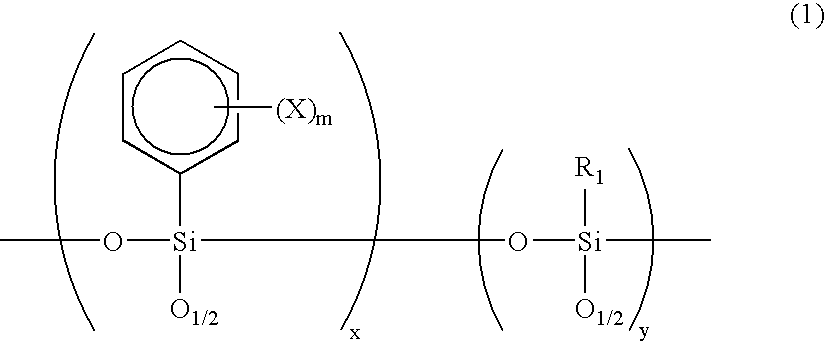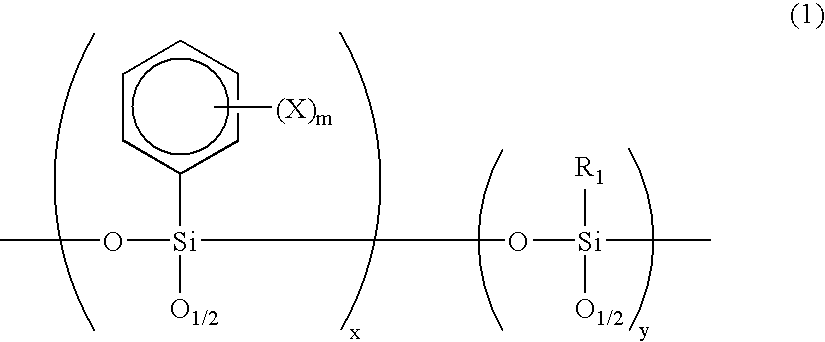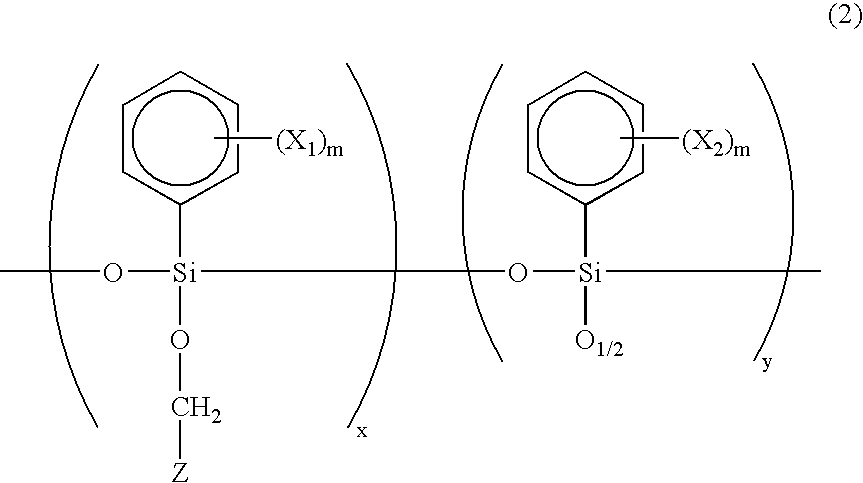Photosensitive composition for manufacturing optical waveguide, production method thereof and polymer optical waveguide pattern formation method using the same
a technology of optical waveguides and compositions, applied in the field of polymer optical waveguide pattern formation, can solve the problems of difficult simultaneous realization of difficult to realize intermixing between core and clad layer, and difficult to achieve heat stability and optical isotropy, etc., to achieve simple pattern formability, reduce the effect of overlapping
- Summary
- Abstract
- Description
- Claims
- Application Information
AI Technical Summary
Benefits of technology
Problems solved by technology
Method used
Image
Examples
example 1
[0070] Phenyltrichlorosilane (211.5 g) and methyltrichlorosilane (36.3 g) were dissolved in 1 liter of anhydrous tetrahydrofuran, and 3 equivalents of water (67.5 g) was slowly added dropwise to the solution so that the liquid temperature does not increase. After that, 315 g of sodium hydrogencarbonate was added while agitating the reaction liquid. After the completion of carbon dioxide gas evolution, agitation was continued for further 1 hour. Next, the reaction liquid was filtered, then tetrahydrofuran was distilled out by a rotary evaporator to give a colorless, transparent viscous liquid. Further, this liquid was vacuum dried to give an oligomer A. The molecular weight of resulting oligomer A was measured by GPC and the result was Mw=3300, Mn=1500.
[0071] Next, a photosensitive substance A was prepared which comprises 50 g of oligomer A, 25 g of UV resin, 2 weight % of N-benzyl-4-benzoylpyridi-nium hexafluoroantimonate as a photopolymerization initiator and 25 g of methylisobutyl...
example 2
[0073] A photosensitive substance B was prepared which comprises 50 g of the oligomer A produced in Example 1, 1 g of (3-glycidoxypropyl) trimethoxysilane as a crosslinking agent, 2 weight % of N-benzyl-4-benzoylpyridinium hexafluoroantimonate as a photopolymerization initiator, and 25 g of methylisobutylketone as a solvent.
[0074] Using the same procedure as in Example 1 except that the photosensitive substance B was used in place of the photosensitive substance A as a core part forming photosensitive substance, a buried type channel optical waveguide comprising a core-clad layer structure as shown in FIG. 1D was produced. In this case, the thickness of the upper clad is 8 .mu.m from the upper surface of the core. Further, no intermixing was noted between the lower clad layer and the core part formation layer.
[0075] As in Example 1, the resulting optical waveguide was cut to a length of 5 cm by a dicing saw, and measured for optical propagation loss which showed 0.5 dB / cm at wavelen...
example 3
[0076] Oligomer B was produced using the same procedure as in Example 1 except that deuterated phenyltrichlorosilane was used in place of phenyltrichlorosilane in the production of oligomer A in Example 1. and a photosensitive substance C was produced using the same procedure as in Example 2 except that oligomer B was used in place of oligomer A. Next, a buried type channel optical waveguide of core diameter 8 .mu.m.times.8 .mu.m was produced by the same process as in Example 2.
[0077] The resulting optical waveguide was cut to a length of 5 cm by a dicing saw, and measured for optical propagation loss which showed 0.1 dB / cm at wavelength 1.3 .mu.m, and 0.5 dB / cm or less at wavelength 1.55 .mu.m. Further, this optical propagation loss of the waveguide was unchanged for more than 1 month under the condition of 75.degree. C. / 90% RH.
PUM
| Property | Measurement | Unit |
|---|---|---|
| thickness | aaaaa | aaaaa |
| thickness | aaaaa | aaaaa |
| width | aaaaa | aaaaa |
Abstract
Description
Claims
Application Information
 Login to View More
Login to View More - R&D
- Intellectual Property
- Life Sciences
- Materials
- Tech Scout
- Unparalleled Data Quality
- Higher Quality Content
- 60% Fewer Hallucinations
Browse by: Latest US Patents, China's latest patents, Technical Efficacy Thesaurus, Application Domain, Technology Topic, Popular Technical Reports.
© 2025 PatSnap. All rights reserved.Legal|Privacy policy|Modern Slavery Act Transparency Statement|Sitemap|About US| Contact US: help@patsnap.com



